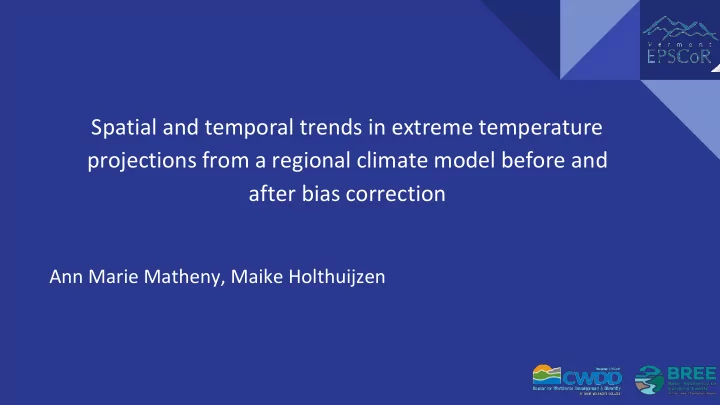

Spatial and temporal trends in extreme temperature projections from a regional climate model before and after bias correction Ann Marie Matheny, Maike Holthuijzen
Introduction The Lake Champlain watershed is vulnerable to changes in patterns ● of extreme climate events Global Climate Models (GCM) can simulate climate change but ● resolution is too low ○ Regional climate models (RCMs) can simulate at a finer resolution and take into account topography and orography ○ The Weather Research and Forecasting Model (WRF) is a commonly assessed RCM Distributional Biases are a common byproduct of climate models ● ○ Bias correction adjusts models simulations to match observed data ○ Quantile Mapping
Objectives 1. Examine spatial and temporal patterns of extreme distributions of maximum temperature from WRF and station data 2. Evaluate the performance of three implementations of a bias correction technique on extreme temperature projections from WRF
Methods and Data ● ● Model Data: WRF projections Quantifying the accuracy of WRF through ● Station Data: daily observations from Global Perkins Skills Scores a measure of Historical Climate Network overlap between two distributions Time period: 1980-2014 ● ● Quantifying the accuracy of WRF through Extreme Event: upper 90th percentile Annual Correction, Monthly ● distribution of TMAX Correction, and Train/Test 73 stations paired to nearest WRF point ● Correction
Perkins Score of 1 Overlapping PDF distributions illustrating the total skill score in a Perkins Score of 0 near-perfect skill score Overlapping PDF test (0.9) distributions illustrating the total skill score in a a very poor skill score (0.02)
How Bias Correction Works Step 1 Evaluating the empirical CDF of Step 3 the entire time series of the raw T he resulting probability is then WRF data evaluated with the inverse empirical CDF of the entire time series of the observed data Step 2 Evaluate Step 1 with uncorrected value of temperature at day
Preliminary exploratory analysis
Spatial patterns of Perkins skill scores Before After
Comparing raw WRF, bias corrected WRF, and station extreme temperature distributions
Average Perkins Scores Comparison ● Initial Perkins score: 0.62 Monthly Correction: 0.82 1. Annual Correction: 0.81 2. Train/Test: 0.78 3.
Discussion ● Variation of raw skill scores in the southeast quadrant of the study area ○ After bias correction, variability decreased, validating the effectiveness of the bias correction technique ● Larger skill scores in southern Quebec compared to other regions of study area ○ Less complex topography in Canada ● Monthly bias correction performed best ● WRF consistently overestimated maximum daily temperatures during winter months
Conclusion This study serves as a first step in aiding the scientific community’s effort to better estimate, capture, and adapt to extreme weather events.
References Alex J. Cannon, Stephen R. Sobie, and Trevor Q. Murdock. Bias correction of gcm precipitation by quantile mapping: How well do methods preserve changes in quantiles and extremes? Journal of Climate , 28( 17) :6938 – 6959, Sep 2015. Xin-Zhong Liang, Min Xu, Xing Yuan, Tiejun Ling, Hyun I. Choi, Feng Zhang, Ligang Chen, Shuyan Liu, Shenjian Su, Fengxue Qiao, and et al. Regional climate – weather research and forecasting model. Bulletin of the American Meteorological Society , 93(9):1363 – 1387, Sep 2012. S. E. Perkins, A. J. Pitman, N. J. Holbrook, and J. Mcaneney . Evaluation of the ar4 climate models’ simulated daily maximum temperature, minimum temperature, and precipitation over australia using probability density functions. Journal of Climate , 20(17):4356 – 4376, Jan 2007. Michael A. Rawlins and Cort J. Willmott. Winter air temperature change over the terrestrial arctic, 1961 – 1990. Arctic, Antarctic, and Alpine Research , 35(4):530 – 537, Jan 2018. Laurence J. Wilson. Comments on “calibrated surface temperature forecasts from the canadian ensemble prediction system using bayesian model averaging”. Monthly Weather Review , 135(12):4226 – 4230, Apr 2007
Recommend
More recommend